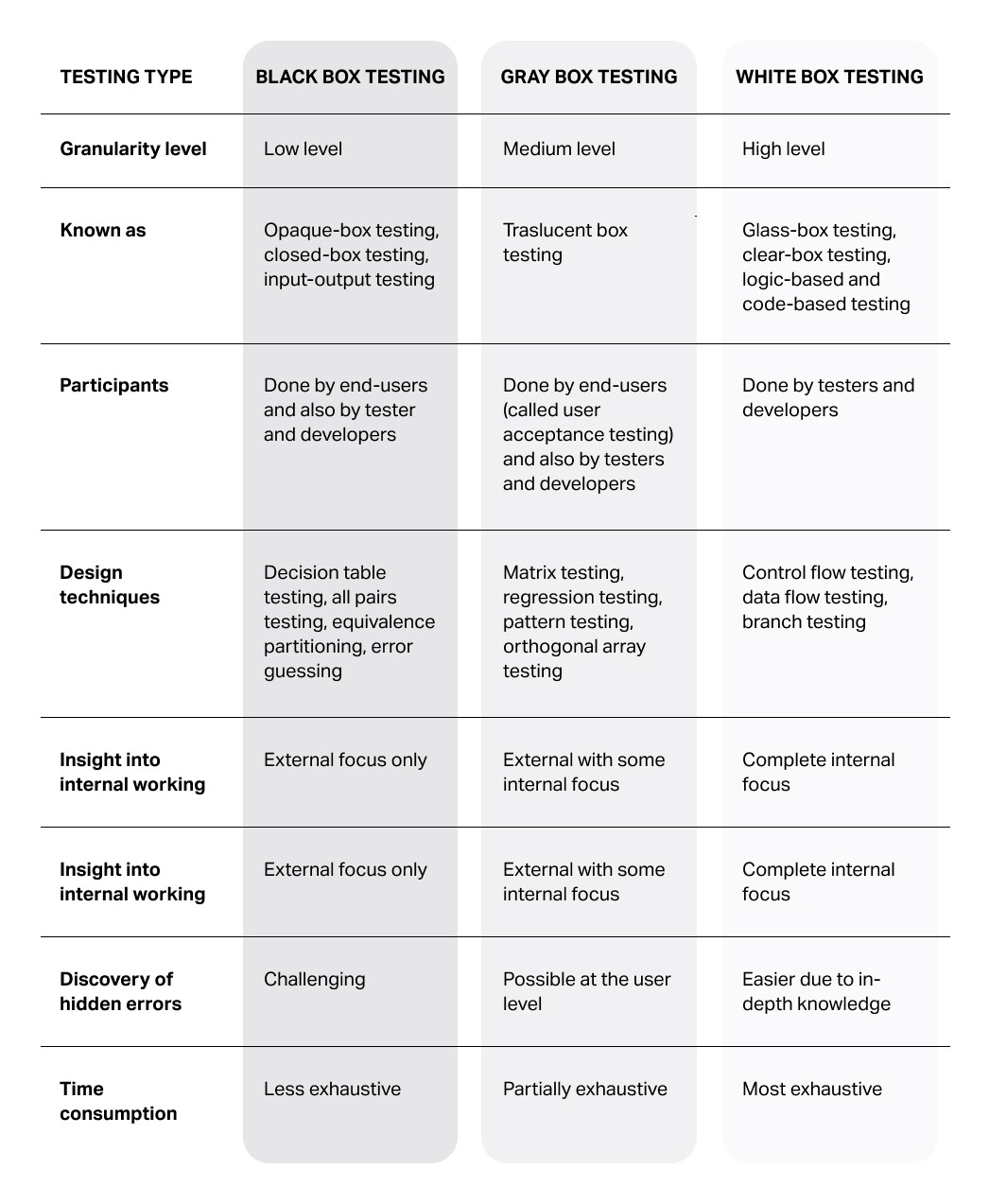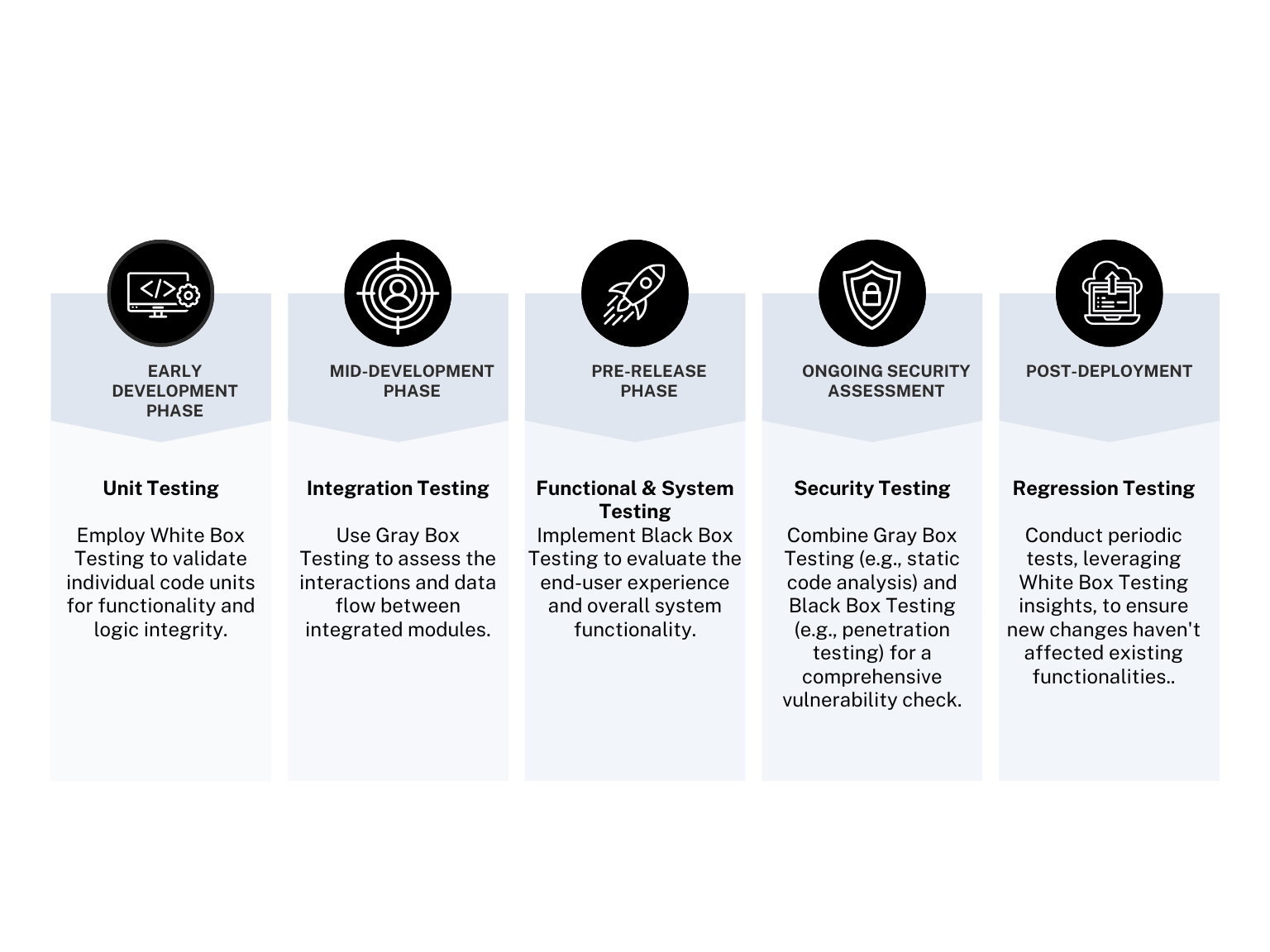White Box, Gray Box, and Black Box Testing – Unpacking The Trio

Functional testing is important in the software development process and is employed by around 90% of development teams, according to Huttle Research. It ensures software performs as intended through different methodologies such as white box, black box, and gray box testing.
However, choosing the right approach can be complex, involving considerations like project requirements, team expertise, and specific software characteristics. Therefore, it is crucial to understand these three testing methodologies to optimize testing strategies and improve software quality.
In this article, we will explain and discuss the differences between white box, gray box and black box software testing methodologies and how they can be integrated for maximum effectiveness.
What Is White Box Testing
White Box Testing is a technique for testing a software’s internal structure, design, and coding. It verifies the flow of inputs and outputs, checks the functionality of conditional loops, and tests each statement, object, and function individually. White box testing is essential for teams to ensure their application’s code is robust and secure. It also examines the code for broken or inefficient paths, ensuring all possible inputs produce the expected output.
White Box Applications
Let’s delve into why it’s essential:
- Complete Code Coverage: Testers have access to the source code and design documents, which allows them to inspect and verify the software’s inner functions, infrastructure, and integrations.
- Automation and Efficiency: Test cases can be easily automated in White Box Testing, saving time and resources.
- Optimization and Error Detection: White Box Testing helps in code optimization by identifying hidden errors, redundancies, and inefficiencies.
- In-Depth Understanding: Having an in-depth understanding of the software’s inner workings is invaluable for future development, maintenance, and troubleshooting.
White Box Testing Techniques and Tools
- Path Coverage – Path coverage involves writing unit tests for all paths in a program’s code flow and asserting inefficiencies or redundant paths.
- Branch Coverage – Branch coverage refers to finding all conditional and unconditional code branches, and then writing unit tests.
For example:
if (expression X is True)
Run code A
Run code B
Else
Run code C
Codes A and C are conditional branches and code B is an unconditional branch, as it will run regardless of whether X is true.
- Unit Testing: Focuses on individual functions or methods within the codebase. Tools like JUnit for Java applications and pytest for Python projects are commonly used.
- Integration Testing: Verifies that different software components/modules integrate smoothly. Tools like TestNG for Java applications and Mockito for creating mock objects are used.
- Static Code Analysis: Analyzes the code without executing it and detects code smells, vulnerabilities, and adherence to coding standards. Tools like SonarQube and ESLint can perform the analysis.
What Teams Should Consider
When conducting white box testing, it’s crucial to address several potential challenges to ensure a thorough and effective process:
- Understanding Complexity: Teams need a comprehensive understanding and the ability to read internal code, which can be costly and challenging due to complex logic and data flows.
- Achieving Full Code Coverage: Fully testing every possible path within the software is often challenging due to time or expertise limitations, potentially leaving some areas untested.
- Security Testing Expertise: Identifying security vulnerabilities requires specific knowledge in secure coding practices and common attack vectors, which might be lacking.
- Resource Demands: This testing method can be resource-intensive, often involving detailed manual code review that demands significant time and personnel.
What Is Black Box Testing?
Black box testing is a key methodology in SDLC. It focuses on testing a software application’s external functionality without examining its internal code structure.
Using this approach, we examine the software from the end user’s perspective, scrutinizing its conformance to the requirements and its behavior in various input scenarios. This method supports early issue detection in the development process, promoting efficiency and reducing rework.
Black Box Testing Applications
Black box testing finds application across multiple stages and aspects of the software testing lifecycle, including:
- Acceptance Testing to check if software fulfills business needs and is deployable.
- Functional verification to check that software functions match requirements.
- Non-Functional Testing to review performance, usability, and external security.
Black Box Testing Techniques and Tools
In black box testing, a set of techniques is used to explore the application’s functional boundaries in an attempt to identify potential flaws from the outside:
- Equivalence Partitioning: This technique divides input data into equivalent partitions that generate similar behavior from the software, streamlining test case design to cover a broad range of inputs efficiently. Consider testing a password text field where users can enter between six and ten characters. This set can be divided into three equivalence classes:
- Less than 6 characters – fail the test
- >= 6 and
- > 10 characters – the test should fail. Instead of testing the entire class, we typically test one value from each group.
- Boundary Value Analysis (BVA): BVA examines the boundary conditions of input domains, where applications are most likely to encounter errors. In general, the boundary value consists of minValue, minValue + 1, maxValue, and maxValue +1. In the above password field testing, 6 is the minValue, and 10 is the maxValue.
- Decision Table Testing: This method maps different input combinations to their expected outcomes, providing a structured way to identify errors in application logic.
- State Transition Testing: By examining the software’s behavior across various states and transitions, testers can uncover issues in the state management logic.
Black Box Testing Tools
Relevant tools that facilitate black box testing include TestRail, Selenium for web applications, Appium for mobile testing, and SoapUI for API testing.
What Teams Should Consider?
When performing black box testing, teams should be mindful of several common pitfalls to ensure effective and comprehensive testing:
- Limited Internal Code Knowledge: Understand the limitations of not having access to the internal code, which can obscure potential defects or vulnerabilities not apparent from the outside.
- Balance Between Realism and Thoroughness: Aim to strike a balance between modeling real-world user scenarios (realism) and conducting a thorough evaluation to uncover all possible issues, including those that might not be immediately visible.
- Scalability Challenges: As software projects grow, the complexity and scope of black box testing can increase significantly. Make sure that all critical functionalities and edge cases are covered in large applications by planning and adapting testing strategies.
- Dependency on Requirements: Black box testing heavily relies on well-documented and accurate requirements. Ensure these requirements are comprehensive and up-to-date to avoid missing critical tests or misinterpreting the intended functionality.

Helpful Tip: If requirement documentation doesn’t exist or is not referenceable, exploratory testing can help understand app functionality before you conduct black box testing.
What Is Gray Box Testing?
Gray box testing can be defined as a hybrid methodology combining white box and black box testing principles. It allows testers to work with partial knowledge of the internal workings of an application.
This approach enables more targeted testing of complex, real-world scenarios and efficient detection of security flaws, logical errors, and functional issues. Gray box testing facilitates a comprehensive and efficient evaluation process by leveraging both the developer’s insights and the tester’s perspective, ensuring software quality and reliability.
Gray Box Testing Applications
Gray box testing is particularly effective in scenarios where both the system’s functionality and its internal operations are of interest, e.g.
- Integrates components seamlessly, which is critical for integration testing
- Uses architectural knowledge to simulate security scenarios and enhance security testing.
- Conducts in-depth software performance evaluations in system-wide testing.
Gray Box Testing Techniques
Gray box testing employs various techniques to maximize its dual-knowledge advantage, including:
- Matrix Testing: It involves creating a matrix to identify variables and their direct or indirect influence on each other, helping in uncovering hidden errors.
- Pattern Testing: It identifies recurring patterns within the software to predict potential future errors based on historical data.
- Boundary Value Analysis: This technique is tailored for gray box testing by leveraging the tester’s partial knowledge to more accurately define boundary conditions.
- State Transition Testing: This approach examines the software’s behavior across different states, using internal knowledge to test transitions more thoroughly.
Gray Box Testing Tools
Tools that facilitate gray box testing incorporate features that support internal and external perspectives. Tools like Selenium, Appium for mobile testing, and Postman for API testing are further improved by JUnit, NUnit for unit testing, and more specialized tools like Burp Suite for security assessments.
What Teams Should Consider?
Gray Box Testing offers valuable insights. However, there are certain pitfalls that teams should be aware of:
- Over Reliance on Partial Knowledge: Gray box testing relies on limited information about the internal workings of the software. However, this partial awareness can lead to assumptions or gaps in test coverage. Teams should avoid relying solely on gray box testing and complement it with other techniques.
- Biased Testing: Since testers have some knowledge of the software, they may unconsciously avoid certain areas or overlook potential vulnerabilities. Maintaining an objective perspective and not favoring specific components during testing is essential.
- Inadequate Coverage: Gray box testing might not fully explore all aspects of the software. Teams should ensure that critical areas are thoroughly tested using other methods, such as black-box or white-box testing.
- Lack of Tooling and Techniques: Finding suitable tools and techniques for gray box testing can be challenging. Teams should invest in robust tools that facilitate effective gray box testing without disrupting normal software functioning.
White Box Vs Gray Box Vs Black Box Testing
Black Box, Gray Box, and White Box testing each provide unique approaches and levels of insight into software testing.
Black Box testing focuses on external system behavior without knowledge of the internals, making it ideal for end-user-driven scenarios and functional testing. It is the least granular but highly effective for verifying that the system meets specified requirements.
White Box testing provides the most detailed view, with complete access to internal code and architecture. Hence, it is best suited for complex situations where understanding the behavior of the code is important for the performance and security of the software.
Gray Box testing offers a middle ground. It requires some knowledge of the internal workings and provides for more targeted testing. It relies on an understanding of the system’s architecture without full access to the code.
Each testing method addresses different needs and offers varying levels of depth and breadth in testing, making them complementary components of a thorough software testing strategy. Below is a side-by-side comparison of the three types of testing, highlighting differences in methodology, focus, advantages, and limitations.

Integrating Testing Methodologies for Comprehensive Quality Assurance
These three methodologies can be integrated into the Software Development Life Cycle (SDLC) to identify several issues, such as specific code bugs and user experience issues. This section focuses on integration strategies for quality assurance in software testing, supported by a case study highlighting the successful application.
Strategies for Integration
During the early development phase, developers utilize White Box Testing to perform unit tests to validate individual components or functions. As the mid-development phase approaches, Gray Box Testing comes into play for integration tests to evaluate interactions and data flow between components.
In the pre-release phase, Black Box Testing is implemented for functional and system testing. It evaluates the software from an end-user’s perspective without considering the internal code structure. For ongoing security assessment, a combination of Gray and Black Box Testing methods is recommended. Static code analysis and penetration testing combined can uncover vulnerabilities that might not be apparent from a single perspective.
Finally, in the post-deployment phase, White Box Testing ensures that new updates or patches don’t negatively affect existing functionality through regular regression testing.
The following image illustrates how each type of integration takes place at different phases:

Example Of Integrating White, Gray & Black Box Testing
Case Study: E-commerce Platform Upgrade
An e-commerce platform underwent a significant upgrade to enhance its user interface, payment processing, and overall functionality. Integrating different testing methodologies played a pivotal role in the upgrade’s success.
- Unit Testing (White Box): Developers focused on the payment processing functions, creating unit tests that verified calculations, error handling, and edge cases, catching potential issues early in the development cycle.
- Integration Testing (Gray Box): The team then tested the interactions between the payment gateway and order processing modules. Leveraging their architectural knowledge, they validated data exchange, security protocols, and comprehensive error handling.
- Functional Testing (Black Box): Testers conducted end-to-end tests on the order placement process, including payment flow, inventory updates, and shipping notifications, ensuring a seamless user experience.
- Security Testing (Gray + Black Box): A combination of static code analysis (Gray Box) and penetration testing (Black Box) identified SQL injection vulnerabilities and secured API endpoints, validating encryption and authentication mechanisms.
- Regression Testing (White Box Insights): Following updates, the team re-ran unit tests to ensure payment-related functions remained intact and to prevent unintended side effects.
Strategically Combining Testing Techniques for Comprehensive Coverage
Software testing within the SDLC ensures quality, functionality, and conformance to requirements. White Box Testing delves into internal structures, Gray Box Testing offers a hybrid approach, and Black Box Testing focuses on user-facing functions.
By strategically combining these three methods, you can achieve a comprehensive evaluation of both internal operations and external functionalities, enhancing software quality across every phase of the development lifecycle.
Schedule a call with an expert on our team to discover how Testlio’s tailored QA solutions can help you optimize your testing strategies and achieve superior software quality!
